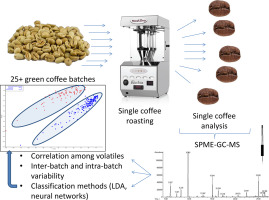Food Research International ( IF 7.0 ) Pub Date : 2018-04-03 , DOI: 10.1016/j.foodres.2018.03.077 Nicola Caporaso 1 , Martin B Whitworth 2 , Chenhao Cui 3 , Ian D Fisk 4

|
We report on the analysis of volatile compounds by SPME-GC-MS for individual roasted coffee beans. The aim was to understand the relative abundance and variability of volatile compounds between individual roasted coffee beans at constant roasting conditions. Twenty-five batches of Arabica and robusta species were sampled from 13 countries, and 10 single coffee beans randomly selected from each batch were individually roasted in a fluidised-bed roaster at 210 °C for 3 min. High variability (CV = 14.0–53.3%) of 50 volatile compounds in roasted coffee was obtained within batches (10 beans per batch). Phenols and heterocyclic nitrogen compounds generally had higher intra-batch variation, while ketones were the most uniform compounds (CV < 20%). The variation between batches was much higher, with the CV ranging from 15.6 to 179.3%. The highest variation was observed for 2,3-butanediol, 3-ethylpyridine and hexanal. It was also possible to build classification models based on geographical origin, obtaining 99.5% and 90.8% accuracy using LDA or MLR classifiers respectively, and classification between Arabica and robusta beans. These results give further insight into natural variation of coffee aroma and could be used to obtain higher quality and more consistent final products. Our results suggest that coffee volatile concentration is also influenced by other factors than simply the roasting degree, especially green coffee composition, which is in turn influenced by the coffee species, geographical origin, ripening stage and pre- and post-harvest processing.
中文翻译:

用 SPME-GC-MS 分析阿拉比卡和罗布斯塔烘焙咖啡单豆咖啡挥发性化合物的变异性
我们报告了通过 SPME-GC-MS 对单个烘焙咖啡豆的挥发性化合物进行的分析。目的是了解在恒定烘焙条件下单个烘焙咖啡豆之间挥发性化合物的相对丰度和变异性。从 13 个国家采样了 25 批阿拉比卡和罗布斯塔咖啡豆,从每批中随机挑选 10 颗咖啡豆,在流化床烘焙机中在 210 °C 下单独烘焙 3 分钟。烘焙咖啡中 50 种挥发性化合物在批次内(每批次 10 颗咖啡豆)的变异性较高(CV = 14.0–53.3%)。酚类和杂环氮化合物通常具有较高的批次内变异,而酮类是最均匀的化合物(CV < 20%)。批次之间的差异要大得多,CV 范围为 15.6% 至 179.3%。 2,3-丁二醇、3-乙基吡啶和己醛的变化最大。还可以建立基于地理来源的分类模型,使用LDA或MLR分类器分别获得99.5%和90.8%的准确率,以及阿拉比卡和罗布斯塔豆之间的分类。这些结果可以进一步了解咖啡香气的自然变化,并可用于获得更高质量和更一致的最终产品。我们的研究结果表明,咖啡挥发物浓度还受到其他因素的影响,而不仅仅是烘焙程度,特别是生咖啡成分,而生咖啡成分又受到咖啡品种、地理原产地、成熟阶段以及收获前后加工的影响。











































 京公网安备 11010802027423号
京公网安备 11010802027423号